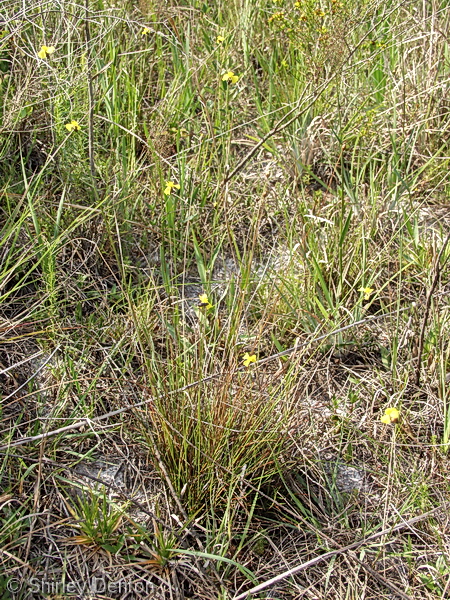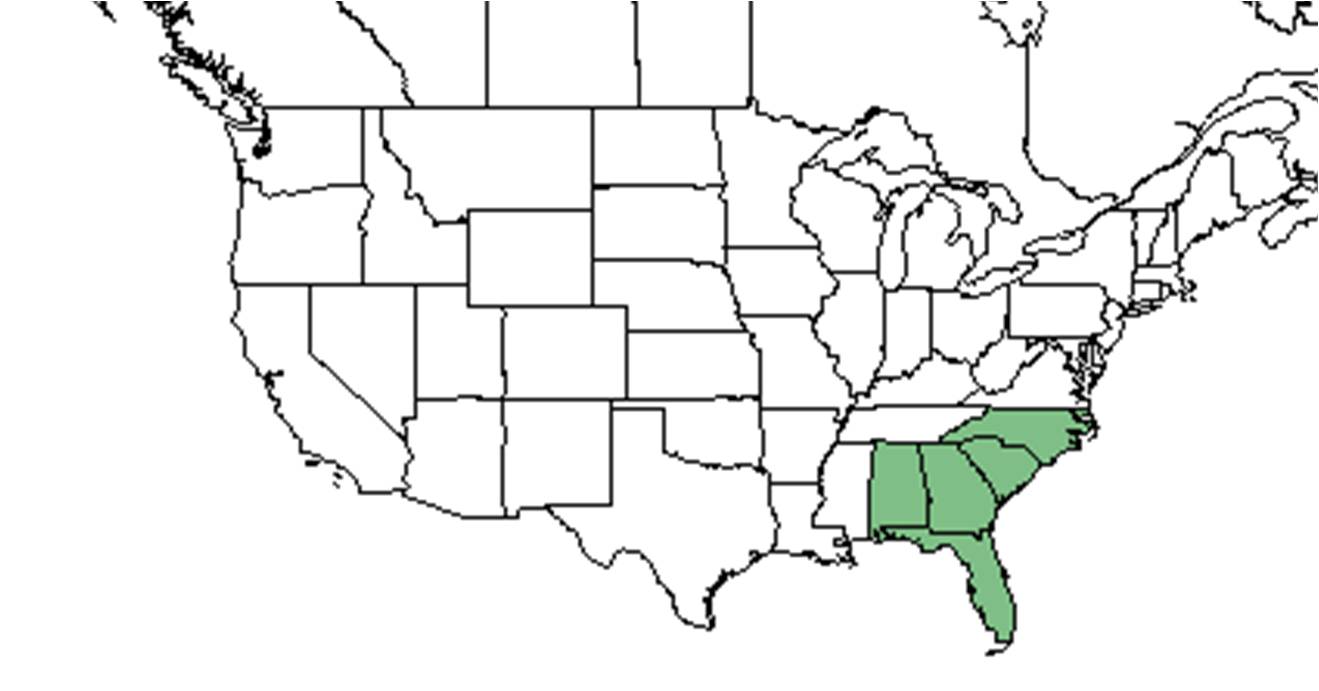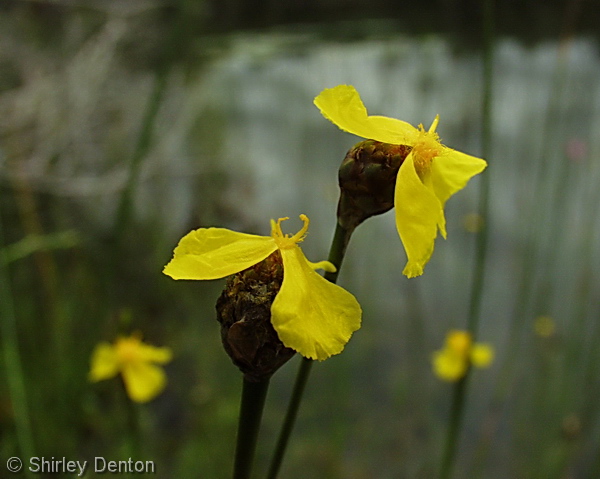Difference between revisions of "Xyris elliottii"
Lsandstrum (talk | contribs) |
Juliec4335 (talk | contribs) |
||
| Line 32: | Line 32: | ||
Associated species include ''Decodon, Drosera, Polygala, Spartina patens, Centella asiatica, Lycopodium, Syngonanthus flavidulus, Panicum hemitomon, Scleria reticularis, Rhynchospora, Andropogon, Juncus, Amphicarpum muhlenbergianum, Lycopodium appressum, Lachnocaulon engleri, Syngonanthus flavidulus, Sarracenia flava, Polygala, Rhexia, Rhynchospora, Platanthera nivea, Panicum erectifolia, Aster eryngifolius, Rhexia lutea, Polygala chapmanii, Xyris drummondii, X. fimbriata, Scleria reticularis'' and '' Panicum tenerum.'' <ref name="FSU Herbarium"/> | Associated species include ''Decodon, Drosera, Polygala, Spartina patens, Centella asiatica, Lycopodium, Syngonanthus flavidulus, Panicum hemitomon, Scleria reticularis, Rhynchospora, Andropogon, Juncus, Amphicarpum muhlenbergianum, Lycopodium appressum, Lachnocaulon engleri, Syngonanthus flavidulus, Sarracenia flava, Polygala, Rhexia, Rhynchospora, Platanthera nivea, Panicum erectifolia, Aster eryngifolius, Rhexia lutea, Polygala chapmanii, Xyris drummondii, X. fimbriata, Scleria reticularis'' and '' Panicum tenerum.'' <ref name="FSU Herbarium"/> | ||
| + | |||
| + | ''Xyris elliottii'' is an indicator species for the Peninsula Savannas community type as described in Carr et al. (2010).<ref>Carr, S.C., K.M. Robertson, and R.K. Peet. 2010. A vegetation classification of fire-dependent pinelands of Florida. Castanea 75:153-189.</ref> | ||
===Phenology=== <!--Timing off flowering, fruiting, seed dispersal, and environmental triggers. Cite PanFlora website if appropriate: http://www.gilnelson.com/PanFlora/ --> | ===Phenology=== <!--Timing off flowering, fruiting, seed dispersal, and environmental triggers. Cite PanFlora website if appropriate: http://www.gilnelson.com/PanFlora/ --> | ||
Revision as of 12:49, 23 July 2020
| Xyris elliottii | |
|---|---|

| |
| Photo by Shirley Denton (Copyrighted, use by photographer’s permission only), Nature Photography by Shirley Denton | |
| Scientific classification | |
| Kingdom: | Plantae |
| Division: | Magnoliophyta - Flowering plants |
| Class: | Liliopsida – Monocotyledons |
| Order: | Commelinales |
| Family: | Xyridaceae |
| Genus: | Xyris |
| Species: | X. elliottii |
| Binomial name | |
| Xyris elliottii Chapm. | |

| |
| Natural range of Xyris elliottii from USDA NRCS Plants Database. | |
Common name: Elliott's yellow-eyed grass
Contents
Taxonomic notes
Synonyms: Xyris elliottii var. elliottii; Xyris elliottii var. stenotera Malme
Description
A description of Xyris elliottii is provided in The Flora of North America.
Distribution
Ecology
Habitat
Xyris elliotti can occur in floating islands of depression swamps, lake shores, wet pine flatwoods, pine-palmetto flats, dune swales, flatwoods bogs, moist pine barrens, Hypericum marshes, cypress domes, sinkhole lake shores, dune hollows, grass-sedge bogs, cypress-gum swamps, hardwood hammocks, and seepage slopes. It has occurred in disturbed areas such as roadside depressions, drying borrow pit ponds, bulldozed flatwoods, and powerline corridors. [1] Soils types include peaty soil, loamy sand, peaty sand, Mandarin (Typic Haplhumods), Clarendon (Plinthaquic Paleudults), and Pineda and Riviera (Arenic Glossaqualfs). [1] Occurs in pine-palmetto and also wet prairie habitats, occurrence is common, and has a poor forage value.[2] X. elliottii responds negatively or not at all to soil disturbance by roller chopping in South Florida.[3]
Associated species include Decodon, Drosera, Polygala, Spartina patens, Centella asiatica, Lycopodium, Syngonanthus flavidulus, Panicum hemitomon, Scleria reticularis, Rhynchospora, Andropogon, Juncus, Amphicarpum muhlenbergianum, Lycopodium appressum, Lachnocaulon engleri, Syngonanthus flavidulus, Sarracenia flava, Polygala, Rhexia, Rhynchospora, Platanthera nivea, Panicum erectifolia, Aster eryngifolius, Rhexia lutea, Polygala chapmanii, Xyris drummondii, X. fimbriata, Scleria reticularis and Panicum tenerum. [1]
Xyris elliottii is an indicator species for the Peninsula Savannas community type as described in Carr et al. (2010).[4]
Phenology
Flowers and fruits April through September. [1]
Fire ecology
Urban sprawl and fire suppression have caused habitat depletion locally, state-wide, nation-wide, and around the world. Fortunately, there have been pineland communities that have been maintain by natural-set fires. Carr (2010) and her colleagues presented a classification and description of these pineland communities creating comprehensive vegetation surveys for each community type. Within the peninsula savanna, a wetland community type described by Carr (2010), Xyris elliottii occurs with the ground cover vegetation and is one of the indicator species. Peninsula savannas occur in the Coastal Plain Coastal Lowlands where there are high water tables and where seasonal inundation is common. The soil type is sandier and is higher in organic matter with a subsoil that includes low clay and silt. [5]
Pollination
The following Hymenoptera families and species were observed visiting flowers of Xyris elliottii at Archbold Biological Station: [6]
Apidae: Apis mellifera, Bombus impatiens
Colletidae: Colletes distinctus
Halictidae: Augochloropsis sumptuosa, Lasioglossum coreopsis, L. nymphalis
Megachilidae: Megachile brevis pseudobrevis
Use by animals
The Florida Grasshopper Sparrow nest material are made up of grasses and grass-like monocots, such as Xyris elliottii. Other plant species used in making the nests include wiregrass and bluestems.[7]
Conservation and management
The primary threats to Xyris elliottii is mainly mismanagement of the habitat where it thrives. Mismanagement practices include fire suppression, conversion to agriculture, monoculture plantations (such as Pinus elliottii), highway development, and urban sprawl. If this species were to become threatened or endangered, practicing ideal land management by protecting its habitat would help conserve the species.[8]
Cultivation and restoration
Photo Gallery
Flowers of Xyris elliottii Photo by Shirley Denton (Copyrighted, use by photographer’s permission only), Nature Photography by Shirley Denton
References and notes
- ↑ 1.0 1.1 1.2 1.3 Florida State University Robert K. Godfrey Herbarium database. URL: http://herbarium.bio.fsu.edu. Last accessed: November 2015. Collectors: Loran C. Anderson, W.W. Baker, Edwin L. Bridges, Paul M. Cassen, A.H. Curtiss, Angus Gholson Jr., Robert K. Godfrey, Ann F. Johnson, Ed Keppner, Lisa Keppner, Mabel Kral, Robert Kral, O. Lakela, S.W. Leonard, William Lindsey, K. MacClendon, T. MacClendon, Sidney McDaniel, Gil Nelson, Steve Orzell, P.L. Redfearn Jr. , Grady W. Reinert, Jean W. Wooten. States and Counties: Florida: Bay, Bradford, Brevard, Calhoun, Charlotte, Citrus, Clay, Collier, Escambia, Franklin, Gilchrist, Gulf, Hernando, Hillsborough, Indian River, Jackson, Jefferson, Lafayette, Lake, Lee, Leon, Levy, Liberty, Marion, Martin, Okaloosa, Orange, Osceola, Palm Beach, Pasco, Polk, Putnam, Santa Rosa, Sarasota, St. Lucie, St. Johns, Sumter, Taylor, Volusia, Wakulla, Walton, Washington. Countries: Belize.Compiled by Tall Timbers Research Station and Land Conservancy.
- ↑ Hilmon, J.B. (1964). “Plants of the Caloosa Experimental Range.” U.S. Forest Service Research Paper S E – 12.
- ↑ Lewis, C.E. (1970). Responses to Chopping and Rock Phosphate on South Florida Ranges. Journal of Range Management 23(4):276-282.
- ↑ Carr, S.C., K.M. Robertson, and R.K. Peet. 2010. A vegetation classification of fire-dependent pinelands of Florida. Castanea 75:153-189.
- ↑ Carr, Susan C., Kevin M. Robertson, and Robert K. Peet (2010). “A Vegetation Classification of Fire-Dependent Pinelands of Florida.” Castanea 75(2):153-189.
- ↑ Deyrup, M.A. and N.D. 2015. Database of observations of Hymenoptera visitations to flowers of plants on Archbold Biological Station, Florida, USA.
- ↑ Delany, Michael F. and Stephen B. Linda (1998). “Characteristics of Florida Grasshopper Sparrow Nests.” The Wilson Bulletin Vol. 110, No. 1: 136-139.
- ↑ [[1]]IUCN Red List. Accessed: March 15, 2016.
